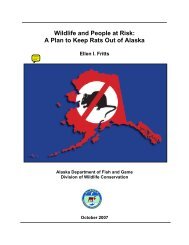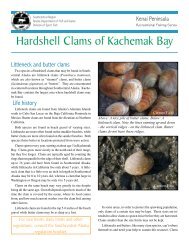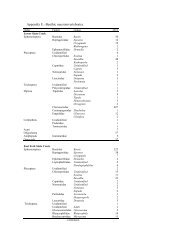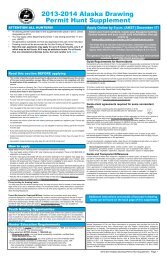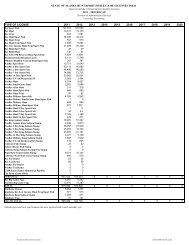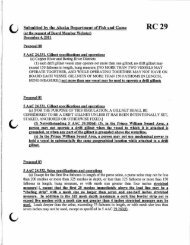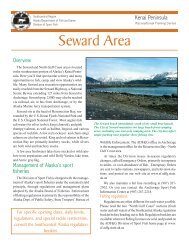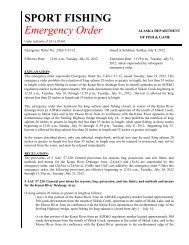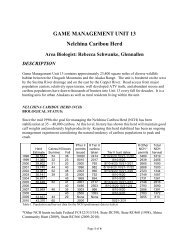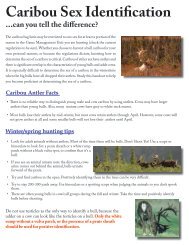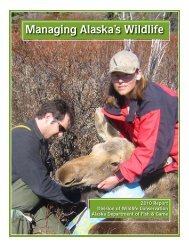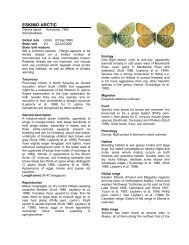fishery management report no. 12–46 - Alaska Department of Fish ...
fishery management report no. 12–46 - Alaska Department of Fish ...
fishery management report no. 12–46 - Alaska Department of Fish ...
Create successful ePaper yourself
Turn your PDF publications into a flip-book with our unique Google optimized e-Paper software.
Long<strong>no</strong>se suckers Catostomus catostomus, <strong>Alaska</strong> blackfish Dallia pectoralis, lake chub<br />
Couesius plumbeus, slimy sculpin Cottus cognatus, and Arctic lamprey Lampetra japonica are<br />
present, but <strong>no</strong>t targeted by sport anglers.<br />
Rainbow trout O. mykiss are <strong>no</strong>t native to the drainage, but have been stocked in many lakes.<br />
Arctic char S. alpinus, coho salmon, king salmon, and Arctic grayling are also stocked in<br />
selected lakes <strong>of</strong> the Tanana River drainage.<br />
ESTABLISHED MANAGEMENT PLANS AND POLICIES<br />
The regulations governing fisheries in the TRMA in 2011 are found in 5 AAC 74.001 through<br />
5 AAC 74.030 (sport fishing), in 5 AAC 77.171 through 5 AAC 77.190 (personal use), and in<br />
5 AAC 01.200 through 5 AAC 01.249 (subsistence fishing). The specific <strong>management</strong> plans that<br />
affect TRMA sport fisheries are the: Minto Flats Northern Pike Management Plans (5 AAC<br />
74.044 for the sport <strong>fishery</strong> and 5 AAC 01.244 for the subsistence <strong>fishery</strong>), Tanana River Wild<br />
Arctic Grayling Management Plan (5 AAC 74.055), Chena and Salcha River King Salmon Sport<br />
Harvest Management Plan (5 AAC 74.060), Tanana River Area Stocked Waters Management<br />
Plan (5 AAC 74.065), Tanana River Area Wild Lake Trout Management Plan (5 AAC 74.040),<br />
Yukon River Drainage Fall Chum Management Plan (5 AAC 01.249), Yukon River King Salmon<br />
Management Plan (5 AAC 05.360), and Yukon River Summer Chum Salmon Management Plan<br />
(5 AAC 05.362).<br />
MAJOR ISSUES<br />
Salmon fisheries are <strong>of</strong>ten the most controversial fisheries in <strong>Alaska</strong> and the TRMA is <strong>no</strong><br />
exception. In terms <strong>of</strong> allocation <strong>of</strong> fish, subsistence fisheries have a priority over commercial,<br />
personal use, and/or sport fisheries during times when salmon runs are low. This priority can<br />
lead to regional and user group conflicts when commercial fisheries occur in the Lower Yukon<br />
River before subsistence users in the upper portion <strong>of</strong> the drainage have seen any salmon in their<br />
fish wheels and nets. In recent years, Division <strong>of</strong> Commercial <strong>Fish</strong>eries has implemented<br />
emergency regulations to reduce harvest <strong>of</strong> salmon (particularly king salmon) in the Yukon<br />
River drainage commercial and subsistence fisheries (JTC 2009, 2010).<br />
Subsistence vs. Sport <strong>Fish</strong>eries<br />
Although hook-and-line is a recognized gear type used by subsistence salmon fishers in some<br />
parts <strong>of</strong> <strong>Alaska</strong>, subsistence users <strong>of</strong>ten refer to the catch-and-release practices <strong>of</strong> sport anglers as<br />
playing with food. This <strong>of</strong>ten creates conflict between subsistence users and sport anglers who<br />
may be fishing for an experience and do <strong>no</strong>t necessarily want to keep the fish they catch.<br />
Conversely, the practice <strong>of</strong> subsistence users harvesting large numbers <strong>of</strong> fish is <strong>of</strong>ten<br />
objectionable to sport fishermen. Such a conflict has arisen in recent years between subsistence<br />
and sport users who fish for <strong>no</strong>rthern pike in Minto Flats. Some sport fishermen have stated that<br />
relatively few subsistence fishermen were locally depleting the <strong>no</strong>rthern pike population and this<br />
would have an adverse effect on the summer spawning population and sport <strong>fishery</strong>.<br />
Habitat Degradation<br />
In 1999, the National Resource Conservation Service (NRCS) implemented a watershed project<br />
designed to prevent sediment-bearing waters from the Granite Mountains from entering the Delta<br />
Clearwater River (DCR; Salcha/Big Delta Soil and Water Conservation District 1987). In the<br />
5




